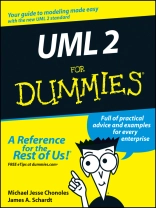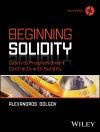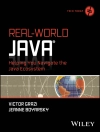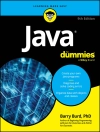* Uses friendly, easy-to-understand For Dummies style to help
readers learn to model systems with the latest version of UML, the
modeling language used by companies throughout the world to develop
blueprints for complex computer systems
* Guides programmers, architects, and business analysts through
applying UML to design large, complex enterprise applications that
enable scalability, security, and robust execution
* Illustrates concepts with mini-cases from different business
domains and provides practical advice and examples
* Covers critical topics for users of UML, including object
modeling, case modeling, advanced dynamic and functional modeling,
and component and deployment modeling
สารบัญ
Introduction 1
Part I: UML and System Development 7
Chapter 1: What’s UML About, Alfie? 9
Chapter 2: Following Best Practices 19
Part II: The Basics of Object Modeling 37
Chapter 3: Objects and Classes 39
Chapter 4: Relating Objects That Work Together 61
Chapter 5: Including the Parts with the Whole 83
Chapter 6: Reusing Superclasses: Generalization and Inheritance 93
Chapter 7: Organizing UML Class Diagrams and Packages 111
Part III: The Basics of Use-Case Modeling 129
Chapter 8: Introducing Use-Case Diagrams 131
Chapter 9: Defining the Inside of a Use Case 147
Chapter 10: Relating Use Cases to Each Other 161
Part IV: The Basics of Functional Modeling 175
Chapter 11: Introducing Functional Modeling 177
Chapter 12: Capturing Scenarios with Sequence Diagrams 189
Chapter 13: Specifying Workflows with Activity Diagrams 213
Chapter 14: Capturing How Objects Collaborate 227
Chapter 15: Capturing the Patterns of Behavior 247
Part V: Dynamic Modeling 259
Chapter 16: Defining the Object’s Lives with States 261
Chapter 17: Interrupting the States by Hosting Events 277
Chapter 18: Avoiding States of Confusion 293
Part VI: Modeling the System’s Architecture 313
Chapter 19: Deploying the System’s Components 315
Chapter 20: Breaking the System into Packages/Subsystems 339
Part VII: The Part of Tens 359
Chapter 21: Ten Common Modeling Mistakes 361
Chapter 22: Ten Useful UML Web Sites 371
Chapter 23: Ten Useful UML Modeling Tools 377
Chapter 24: Ten Diagrams for Quick Development 383
Index 393
เกี่ยวกับผู้แต่ง
Michael Jesse Chonoles ia an established system developer, educator, author, and consultant. Michael has done just about everything that you can do in software and system development–business, requirements, and software analysis; software, system, and architectural design; coding in many languages; testing and quality control–right through marketing, packing, and shrinkwrapping the software. He is former Chief of Methodology at the Advanced Concepts Center (ACC) and has an MSE in Systems Engineering from the University of Pennsylvania and BSs in Math and Physics from MIT.
James A. Schardt is Advanced Concepts Center’s Chief Technologist. He provides 24 years of experience and a firm grounding in object oriented development, data warehousing, and distributed systems. He teaches and mentors Fortune 50 companies in the U.S. and abroad. His many years of practice in object-oriented systems, database design, change management, business engineering, instructional design, and team facilitation bring a wealth of experience to his assignments.












